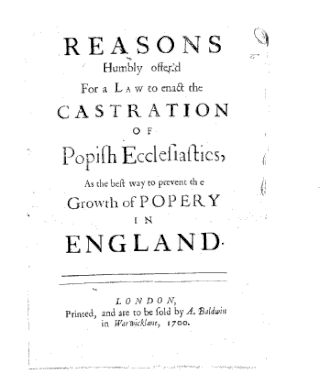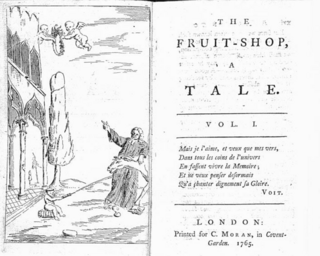Related Research Articles

Henry VIII was King of England from 22 April 1509 until his death in 1547. Henry is known for his six marriages and his efforts to have his first marriage annulled. His disagreement with Pope Clement VII about such an annulment led Henry to initiate the English Reformation, separating the Church of England from papal authority. He appointed himself Supreme Head of the Church of England and dissolved convents and monasteries, for which he was excommunicated by the pope.

Matilda of Tuscany, or Matilda of Canossa, also referred to as la Gran Contessa, was a member of the House of Canossa in the second half of the eleventh century. Matilda was one of the most important governing figures of the Italian Middle Ages. She reigned in a period of constant battles, political intrigues, and Roman Catholic excommunications. She was able to demonstrate an innate and skilled strategic leadership capacity in both military and diplomatic matters.

L'italiana in Algeri is an operatic dramma giocoso in two acts by Gioachino Rossini to an Italian libretto by Angelo Anelli, based on his earlier text set by Luigi Mosca. It premiered at the Teatro San Benedetto in Venice on 22 May 1813. The music is characteristic of Rossini's style, remarkable for its fusion of sustained, manic energy with elegant, pristine melodies.
Theresa Berkley or Berkeley was a 19th-century English dominatrix who ran a brothel in Hallam Street, just to the east of Portland Place, Marylebone, London, specialising in flagellation. She is notable as the inventor of the "chevalet" or "Berkley Horse", a BDSM apparatus.

Henry Spencer Ashbee was a book collector, writer and bibliographer. He is notable for his massive, clandestine three-volume bibliography of erotic literature published under the pseudonym of Pisanus Fraxi.
William Simpson Potter was a 19th-century English author. Potter was a friend of Henry Spencer Ashbee, a merchant, bibliographer, bibliophile, authority on the life and works of Miguel de Cervantes, and collector of erotic materials. Ashbee describes Potter as a "shrewd business man, the ardent collector, and the enthusiastic traveller".
John of Crema was an Italian papal legate and cardinal. He was a close supporter of Pope Callistus II.
William Dugdale was an English publisher, printer, and bookseller of politically subversive publications and pornographic literature in England during the 19th century. By the 1850s he had become "the principal source of such publications in the country". Despite the numerous police raids on his shops and spending many years in prison he remained in the book trade for over forty years.
Edward Sellon (1818–1866) was an English writer, translator, and illustrator of erotic literature.

Isabella I, also called Isabella the Catholic, was Queen of Castile and León from 1474 until her death in 1504. She was also Queen of Aragon from 1479 until her death as the wife of King Ferdinand II. Reigning together over a dynastically unified Spain, Isabella and Ferdinand are known as the Catholic Monarchs.
James Campbell Reddie was a 19th-century British solicitor, collector and author of pornography, who, writing as "James Campbell", worked for the publisher William Dugdale. According to Henry Spencer Ashbee, Reddie was self-taught and viewed his works from a philosophical point of view.
The Amours of Sainfroid and Eulalia or Venus in the Cloister is a pornographic book published in New York City in 1854, translated from the French Les Amours de Sainfroit, jésuite, et Eulalie, fille dévote published by Isaac van der Kloot at The Hague in 1729. It is an anticlerical account of the seduction of a nun by a Jesuit priest. Henry Spencer Ashbee suggests that it is based on an historical incident in Toulon in 1728–29, involving Jesuit priest Jean-Baptiste Girard and alleged witch Catherine Cadière.

Nelly Erichsen was an English illustrator and painter. Born in Newcastle upon Tyne, she was born into a wealthy professional Danish family. After studies at the Royal Academy of Art in the 1880s, she pursued a successful career as an illustrator and writer, working with a number of publishing firms including J.M. Dent and Macmillan, and jointly publishing travel books with Janet Ross, a prominent member of the Anglo-Tuscan pre-War community. In July 2018 Nelly Erichsen - A Hidden Life, a biography of Erichsen by Sarah Harkness was published.
Peter Vannes was an Italian Catholic churchman who became a royal official in England, and Dean of Salisbury.

Reasons humbly offer'd for a Law to enact the Castration of Popish Ecclesiastic[k]s is an anonymous anti-Catholic quarto pamphlet published in London in 1700. The work has been disputedly attributed to Daniel Defoe.
DonGurlino was a 19th-century Carmelite priest, active in Turin, who was scandalously convicted in 1860 of having seduced and had sexual relations with a number of girls to whom he acted as confessor; he was sentenced to seven years solitary confinement.

The Fruit-Shop, a Tale is an anonymous work of satire with erotic themes printed at London by C. Moran in 1765. A second edition was printed in 1766 for J. Harrison, near Covent Garden. The text is, for the most part, an allegorical and discursive disquisition on the "Fruit-Shop", as the author calls woman, or rather on those parts of her which are more particularly connected with fruit-bearing.
The Modern Rake is an anonymous erotic novel with nine coloured illustrations which was printed at London by J. Sudbury in 1824. The title page describes the plot: The Modern Rake; or, the Life and Adventures of Sir Edward Walford: Containing a Curious and Voluptuous History of his luscious intrigues, with numerous women of fashion, his laughable faux pas, feats of gallantry, debauchery, dissipation, and concubinism! His numerous rapes, seductions, and amatory scrapes. Memoirs of the Beautiful Courtezans with whom he lived; with some Ticklish Songs, Anecdotes, Poetry, &c. Enriched with many Curious Plates.